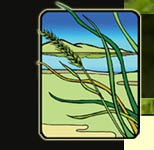Taking an Autumn Walk Through Deanna Giuliano & Aaron Fitch’s California Native Garden
Story and photos by Aaron Fitch
--Deanna-Giuliano-(botanist).jpg)
Sauntering through the magnificent gardens of our home is medicine for the soul. With extensive knowledge of local habitats, and an eye for aesthetic beauty, Deanna Giuliano has created micro habitats throughout the property for the local fauna to thrive upon.
--crab-spider.jpg)
The potential for displaying spectacular Fall color in the garden is ripe with promise. Certain native species have evolved for peak flowering in the late Summer and early Fall. From the kitchen window, the early morning sun illuminates the tall stalks of California Sunflower, Helianthus californicus. As the day warms, honey bees and native bees will be diligently collecting pollen from these radiant disks. As I walk out the front door and amble down the path under the honeysuckle arbor, a dense patch of California aster, Symphyotrichum chilense, graces my view. With lavender ray flowers and complementary yellow disks, these asters are already attracting several different types of buzzing pollinators. Further along, up the rickety wooden stairs and past the vegetable beds, two drippingly ripe pear trees provide an ideal location for a native woodland garden. Hummingbird sage, Salvia spathacea, Woodland strawberry, Fragaria vesca, Snowberry, Symphoricarpos albus, and Hairy honeysuckle, Lonicera hispidula, bestows an exceptional lateral arrangement of foliar leaf patterns and habitat for native fauna to reside. Turning back towards the house, I pass an island garden filled with Mugwort, Artemisia douglasiana and Iris fernaldii, in true Fall representation. Stepping down another staircase, brings me to an eye level view into a Chaparral garden located outside a bedroom window. As I descend, my head is brushed by bursting umbels of the white flowering California buckwheat, Eriogonum fasciculatum. Amongst this Chaparral garden bed are three more woody shrubs, Hooker’s Manzanita, Arctostaphylos hookeri, White sage, Salvia apiana, and Sticky Monkey Flower, Diplacus aurantiacus. In past Falls, I have seen Juncos harvesting S. apiana seeds right off the stock and Towhees scuffing the ground under the manzanita for tiny apples.
With the approach of the Fall season upon us, now is the ideal time to focus on several gardening tasks to prepare your garden for the cooler months ahead. Cutting back herbaceous perennials that have gone to seed, going dormant or appearing straggly will enhance next Springs growth. Creating new garden beds by defining areas and sheet mulching can give you an advantage come planting season. November through February is the best time for planting California natives. Make a list of which natives you want to incorporate into your garden. Check out CCW’s online inventory for current availability.
--Salvia-apiana-(white-sage)--Malacothamnus-fasciculatus-(bush-mallow).jpg)
Incorporating California natives into a garden provides a sense of place and connection to our local surroundings. Creating these “islands” of native habitat is a gesture of reciprocity to the natural world in which we live. By spending time in these gardens surrounding my home, I have come to relate to these gardens as “Living Sanctuaries.” A place to observe and reflect on the wonders of Life that exist all around us.

























